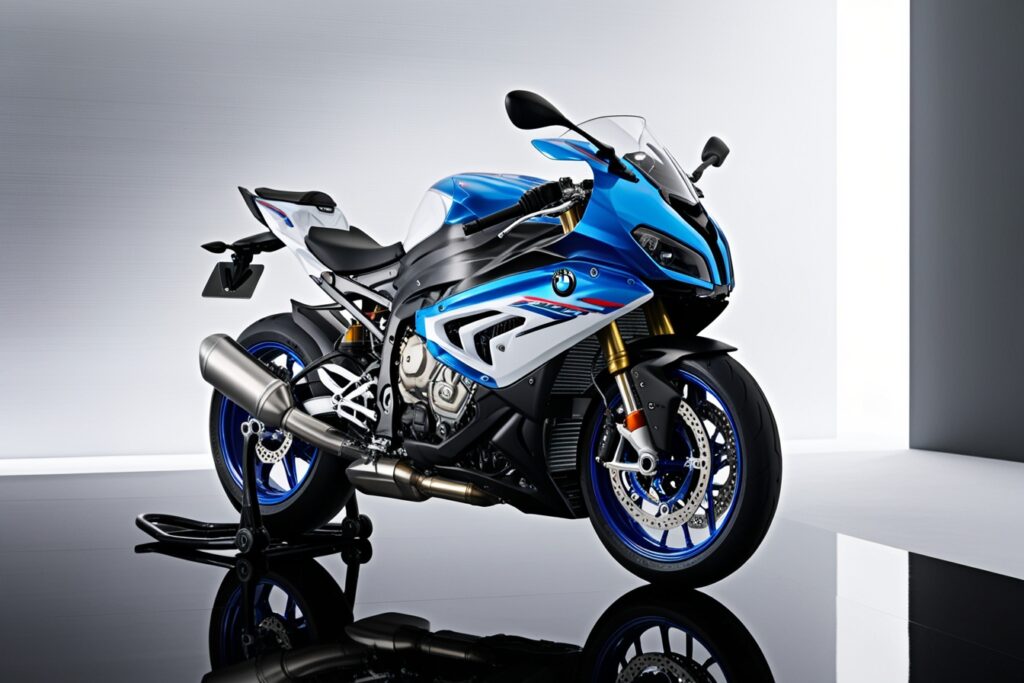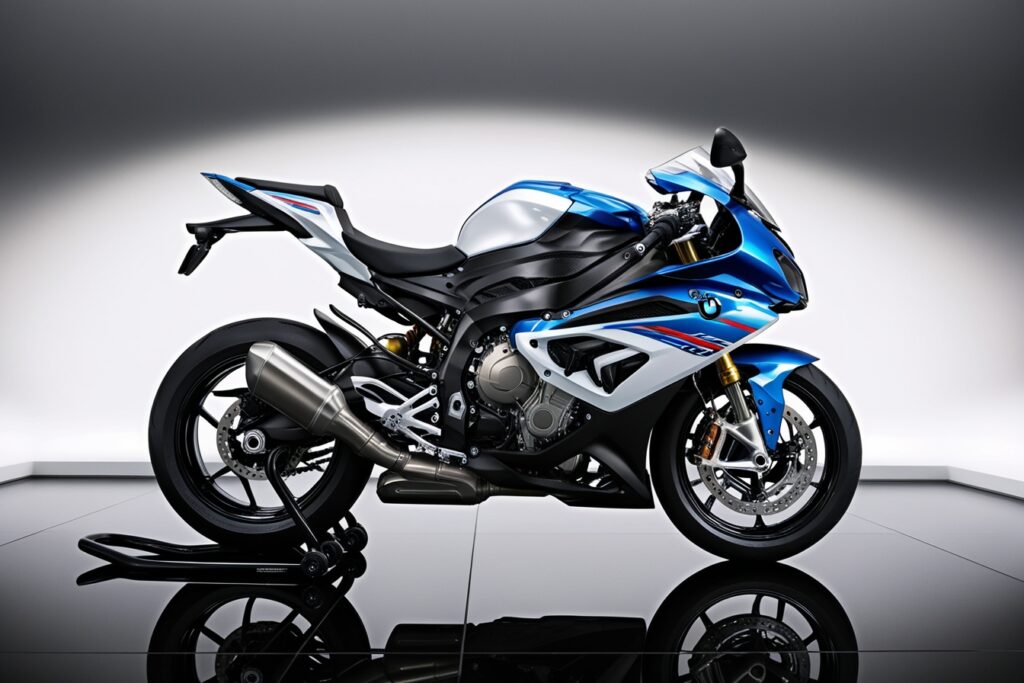The BMW M 1000 RR represents the pinnacle of BMW’s engineering prowess in the world of superbikes. As the first-ever two-wheeler to bear BMW’s prestigious M badge, this motorcycle is a statement of performance, speed, and precision. Built for both the racetrack and the road, the BMW M 1000 RR takes inspiration from BMW’s S 1000 RR, but elevates it to new heights with a host of technical upgrades and aerodynamic improvements. Whether you’re a professional racer or a passionate enthusiast, this motorcycle promises an unparalleled riding experience that combines cutting-edge technology with the raw thrill of speed.
In this comprehensive article, we’ll delve into the rich history of the BMW M series, explore the features that make the BMW M 1000 RR a class-leading machine, and provide an in-depth analysis of its specifications, variants, pricing, pros and cons, and more.

History of BMW M 1000 RR
To understand the significance of the BMW M 1000 RR, it’s important to know about BMW’s M Division. The M (Motorsport) badge has been synonymous with high-performance automobiles for decades, gracing some of the fastest cars on the planet. However, it wasn’t until 2021 that BMW decided to extend its M branding to two wheels with the introduction of the M 1000 RR.
BMW had already established a strong presence in the superbike world with the S 1000 RR, which debuted in 2009. The S 1000 RR revolutionized the segment by offering incredible power, a lightweight design, and top-tier electronics. Building on this platform, BMW Motorrad decided to push the limits even further by creating the M 1000 RR.
The M 1000 RR made its debut as a homologation special for the World Superbike Championship, meaning it was developed to meet the regulations for racing but was also available for the public to purchase. This bike not only serves as BMW’s flagship racing model but also appeals to those looking for a high-performance superbike that delivers both on the track and the road.
Specification Table
| Feature | Specification |
|---|---|
| Engine Type | 999cc, 4-cylinder, liquid-cooled |
| Power Output | 212 hp @ 14,500 rpm |
| Torque | 113 Nm @ 11,000 rpm |
| Transmission | 6-speed with quick-shifter |
| Top Speed | 189 mph (305 km/h) |
| Weight | 192 kg (wet) |
| Frame | Aluminum bridge-type frame |
| Suspension (Front) | Fully adjustable Marzocchi USD fork |
| Suspension (Rear) | Fully adjustable Marzocchi monoshock |
| Brakes | M Carbon brakes, dual 320mm discs (front) |
| Wheelbase | 1,457 mm |
| Fuel Tank Capacity | 16.5 liters |
| Seat Height | 832 mm |
| Electronics | ABS Pro, Dynamic Traction Control (DTC), Wheelie Control, Engine Brake Control, Riding Modes, and Launch Control |
Key Features of BMW M 1000 RR
The BMW M 1000 RR is packed with cutting-edge features designed to enhance performance, control, and rider safety. Here’s a closer look at the key highlights of this incredible machine:

1. Powerful Engine
The heart of the BMW M 1000 RR is its 999cc inline-four engine, derived from the S 1000 RR but upgraded to produce an astonishing 212 horsepower. The engine features BMW’s ShiftCam technology, which optimizes valve timing for improved power delivery and efficiency. Combined with a six-speed gearbox and a quick-shifter, this engine provides blistering acceleration and seamless gear changes, making it perfect for high-speed track days.
2. Aerodynamics
One of the standout features of the M 1000 RR is its aerodynamically optimized design. The bike is equipped with carbon fiber winglets that generate significant downforce at high speeds, helping to improve stability and reduce wheelies under hard acceleration. This is particularly useful on the racetrack, where maintaining control and balance is crucial for shaving off lap times.
3. Lightweight Construction
BMW has extensively used carbon fiber to reduce the overall weight of the bike. The M 1000 RR comes with M Carbon wheels, which are not only lighter than conventional aluminum wheels but also provide improved handling and responsiveness. Other lightweight components include the titanium exhaust system and various carbon fiber body panels, contributing to a wet weight of just 192 kg.
4. Advanced Suspension and Braking
The M 1000 RR is fitted with fully adjustable Marzocchi suspension at the front and rear, allowing riders to fine-tune the bike’s handling characteristics according to their preferences. The braking system is equally impressive, featuring M Carbon brakes with dual 320mm discs at the front, offering exceptional stopping power and heat dissipation, even under the most demanding conditions.
5. Racing Electronics
BMW has loaded the M 1000 RR with an array of electronic aids to enhance rider control and safety. These include:
- ABS Pro: Cornering ABS for optimized braking in all conditions.
- Dynamic Traction Control (DTC): Adjusts power output to prevent wheel slip.
- Wheelie Control: Helps keep the front wheel down under hard acceleration.
- Riding Modes: Customizable settings for different riding conditions (Rain, Road, Dynamic, and Race).
- Launch Control: Ensures optimal acceleration from a standstill.
6. M Carbon Package
For those looking for the ultimate in lightweight performance, the M Carbon Package offers additional carbon fiber components such as the front fender, rear fender, chain guard, and sprocket cover. This package further reduces the bike’s weight while enhancing its aesthetic appeal.
Variants and Colors

The BMW M 1000 RR is available in a single base variant, but BMW offers various customization options and packages to tailor the bike to individual preferences. Some of the popular packages include:
- M Competition Package: Includes additional carbon fiber components, a lightweight battery, and a data logger for analyzing lap times.
- M Endurance Chain: Offers reduced friction and longer life compared to a standard chain.
When it comes to colors, the M 1000 RR is available in two striking finishes:
- Light White/Racing Blue Metallic/Racing Red – The classic BMW M livery that accentuates the bike’s racing pedigree.
- Black Storm Metallic – A more understated, stealthy look for those who prefer a darker aesthetic.
Prices in the US, Europe, and India
United States
The base price for the BMW M 1000 RR in the US starts at around $32,495. However, with additional packages and accessories, the price can easily reach $35,000 or more.
Europe
In Europe, the BMW M 1000 RR is priced starting from €33,500. Like in the US, optional packages and accessories can significantly increase the cost.
India
In India, the BMW M 1000 RR starts at ₹42.5 lakhs (ex-showroom). Given India’s import taxes and duties, the bike is considerably more expensive compared to other markets. With added customization, the price can exceed ₹45 lakhs.
Pros and Cons
Pros
- Outstanding Performance: With over 200 horsepower and a lightweight chassis, the BMW M 1000 RR delivers breathtaking speed and acceleration.
- Racing Pedigree: The bike’s development as a homologation special means it’s been designed to excel on the racetrack, offering features like winglets and race-tuned electronics.
- Carbon Fiber Construction: Extensive use of carbon fiber reduces weight and enhances performance, making the bike easier to handle at high speeds.
- Advanced Electronics: From ABS Pro to Dynamic Traction Control, the M 1000 RR is loaded with rider aids that improve safety and control.
- Customization Options: BMW offers a variety of packages and accessories to personalize the bike according to individual preferences.
Cons
- High Price Tag: With a starting price well over $30,000, the M 1000 RR is one of the most expensive superbikes on the market.
- Limited Practicality: While it excels on the track, the M 1000 RR may not be the most comfortable choice for daily riding or long-distance tours due to its aggressive ergonomics.
- Expensive Maintenance: As with any high-performance machine, maintenance and repair costs can be significant, especially when it comes to specialized components like carbon fiber wheels and M brakes.
Why Buy the BMW M 1000 RR?

1. Track-Ready Performance
If you’re a rider who spends a significant amount of time on the track, the BMW M 1000 RR is an ideal choice. Its combination of power, aerodynamics, and electronics makes it one of the fastest and most capable machines available for track use.
2. Exclusive M Branding
As the first BMW motorcycle to carry the M badge, the M 1000 RR holds a special place in BMW’s lineup. Owning one not only gives you access to a world-class superbike but also a piece of BMW M history.
3. Cutting-Edge Technology
From ShiftCam technology to M Carbon brakes, the BMW M 1000 RR is packed with state-of-the-art features that set it apart from its competitors. If you’re looking for a bike that pushes the boundaries of innovation, this is it.
Competitors
The superbike market is highly competitive, and the BMW M 1000 RR faces stiff competition from other manufacturers. Some of its key rivals include:
- Ducati Panigale V4 R: Ducati’s flagship superbike offers similar power and performance, with a focus on Italian design and engineering.
- Kawasaki Ninja H2R: Known for its supercharged engine, the H2R is one of the most powerful bikes available, but it’s also more extreme and less practical for everyday use.
- Yamaha YZF-R1M: Yamaha’s top-tier superbike offers a more affordable alternative to the M 1000 RR with impressive performance and electronics.
Conclusion
The BMW M 1000 RR is a game-changer in the world of superbikes. With its M Division pedigree, advanced engineering, and top-tier performance, it’s a machine designed for those who demand nothing less than the best. While its high price and specialized nature may limit its appeal to everyday riders, there’s no denying that the M 1000 RR is a masterpiece of motorcycle design and technology. Whether you’re racing on the track or riding on the open road, this bike offers an experience like no other.
FAQs of BMW M 1000 RR
1. What is the top speed of the BMW M 1000 RR?
The BMW M 1000 RR has a top speed of 189 mph (305 km/h).
2. Is the BMW M 1000 RR street-legal?
Yes, the BMW M 1000 RR is street-legal in most countries, although its high-performance nature makes it more suited for track use.
3. What are the main differences between the S 1000 RR and M 1000 RR?
The M 1000 RR features more power, improved aerodynamics (winglets), lighter materials (carbon fiber), and upgraded components compared to the S 1000 RR.
4. Can I customize my BMW M 1000 RR?
Yes, BMW offers various packages and accessories to customize the M 1000 RR, including the M Carbon Package and M Competition Package.
5. What is the price of the BMW M 1000 RR in India?
In India, the BMW M 1000 RR starts at ₹42.5 lakhs (ex-showroom).